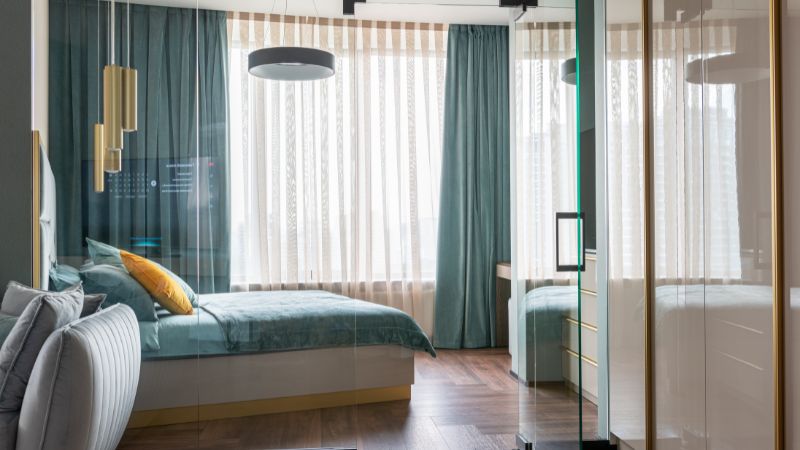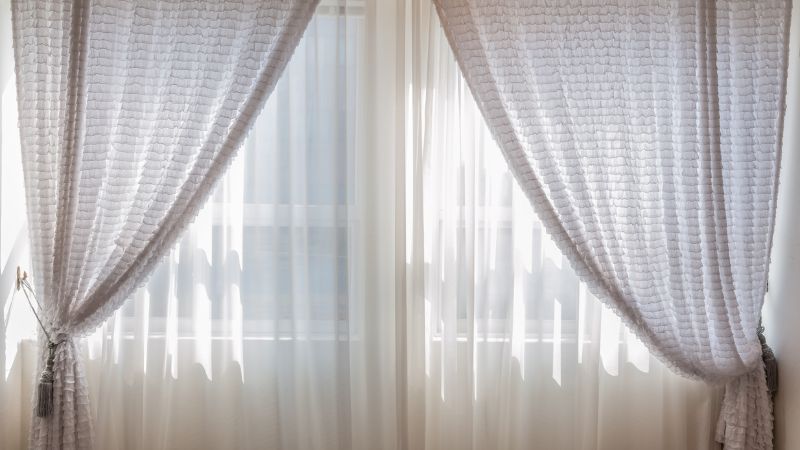
Types of Curtain Fabrics
Curtain materials range from natural options like cotton and linen to synthetic choices like polyester and blends.
Natural Fabrics
Cotton is perhaps the most versatile natural curtain fabric. You’ll find it’s easy to clean, hangs well, and comes in countless colors and patterns.
Cotton curtains work in nearly any room and can be lightweight or heavy depending on your needs.
Linen curtains offer a beautiful, casual elegance with their natural texture. They drape wonderfully and filter light beautifully.
Silk curtains add luxury and a gorgeous sheen to formal spaces. They’re soft, flowing, and catch light in a stunning way.
Synthetic Fabrics
Polyester is incredibly popular for curtains because it’s affordable and durable. Your polyester curtains will resist wrinkles, hold their shape, and stand up to sunlight better than many natural fabrics.
They’re also easy to clean and maintain.
Polyester blends combine the best qualities of different materials. Cotton-polyester blends, for example, give you the natural look of cotton with added durability and wrinkle resistance.
Synthetic velvet offers the luxurious appearance of traditional velvet but with better durability and lower cost.
These curtains create a rich, dramatic look and provide excellent light blocking abilities.
Sateen, a synthetic alternative to silk, gives you that beautiful sheen without the high maintenance.
It drapes well and adds a touch of elegance to your windows at a fraction of the cost of real silk.
Detailed Specific Curtain Styles and Materials
Lace Curtains
Lace curtains bring romantic, vintage charm to your windows. These delicate fabrics filter light beautifully while maintaining some privacy during daylight hours.
You’ll find lace in various patterns, from traditional floral designs to more modern geometric patterns. The intricate details create lovely shadows when sunlight passes through them.
Lace works wonderfully in:
- Cottage-style homes
- Victorian or traditional spaces
- Areas where you want some privacy without blocking light
- Layered with heavier drapes for versatility
Most lace curtains come in white or cream tones, though colored options exist too. They’re lightweight and add a soft, feminine touch to your rooms without overwhelming other design elements.
Sheer Curtains
Sheer curtains transform harsh sunlight into a gentle glow while still letting brightness fill your space.
Made from lightweight fabrics like voile, muslin, or organza, sheers create an airy, relaxed feeling.
You can use sheer curtains alone for a minimal look or layer them with heavier drapes for flexibility. They’re ideal for:
- Living rooms where you want filtered light
- Spaces overlooking private yards
- Creating a breezy, light appearance
- Adding texture without weight
Sheers come in subtle colors and can include simple embroidery or patterns. They move gracefully with air currents, adding gentle movement to your room.
These curtains require gentle washing and typically have a simple hanging style that showcases their flowing nature.
Functionality and Use Cases
The fabric you choose for your curtains affects how they function in your home.
Different materials offer unique benefits for light control, insulation, and daily use.
Light Filtering and Blackout

When it comes to controlling light, your fabric choice matters a lot.
Sheer fabrics like voile or lightweight cotton allow sunlight to filter through, creating a soft glow in your room during the day.
For more privacy, medium-weight fabrics like linen blends work well. They let some light in while preventing people from seeing inside.
If you need total darkness, blackout curtains are your best friend. These special curtains often have acrylic backing or are made from tightly woven fabrics like heavy cotton, polyester, or nylon. They’re perfect for:
- Bedrooms where you need complete darkness
- Home theaters
- Shift workers who sleep during daylight hours
- Nurseries for naptime
Thermal Insulation
Heavier fabrics naturally provide better insulation.
Thick cotton, velvet, and lined draperies act as barriers against heat and cold. During winter, they prevent warm air from escaping through windows. In summer, they block heat from entering your home.
For maximum thermal efficiency, look for:
- Curtains with thermal lining
- Tightly woven fabrics
- Multiple layers
Some fabrics come with special thermal coatings that reflect heat. These work especially well in extreme climates where temperature control is important.
How to Care for the Curtain?

Different curtain fabrics need different care.
Cotton and polyester curtains are usually machine washable, making them easy to maintain. Just check the care label first!
For delicate fabrics like silk or velvet, dry cleaning is often necessary. These fabrics might fade or shrink if washed at home. Linen and synthetic blends are more forgiving and can typically be washed at home.
Regular maintenance helps curtains last longer. Dust your curtains weekly with a vacuum attachment or soft brush. This prevents dirt buildup that can damage fibers over time.
Sun damage is a common issue. Consider rotating curtains in sunny rooms every few months to prevent uneven fading.
Using liners can also protect your main curtains from sun damage and help them last longer.
Always store clean curtains in a dry place if you’re changing them seasonally. This prevents mold and mildew problems.
Installation and Accessories
Once you’ve chosen the perfect curtain fabric, you’ll need to consider how to hang them and what accessories will complete your window treatments.
Hanging Mechanisms
You have several options for hanging your curtains, depending on your window style and fabric weight.
Curtain rods are the most common choice and come in various designs from sleek modern to ornate traditional. For heavier drapery fabric like velvet or lined cotton, choose sturdy rods that can support the weight without sagging.
Traverse rods work well if you plan to open and close your curtains frequently, as they use carriers that glide smoothly along a track. For a hidden hardware look, try ceiling-mounted tracks.
Spring tension rods offer a no-drill solution for lightweight fabrics in smaller windows.
They’re perfect for renters or temporary installations since they press against the inside of your window frame without hardware.
Decorative Additions
Valances add a finished look to your window treatments by hiding the hanging hardware while adding visual interest. These short fabric panels come in various styles—straight, scalloped, or pleated—and can match or contrast with your main curtains.
Tiebacks help manage your curtains when open, creating an elegant draped effect.
Choose from fabric ties, tasseled cords, or decorative holdbacks mounted to your wall. They’re not just functional but add a polished touch to your window design.
Curtain rings and clips offer versatility in hanging, especially for fabrics that might be damaged by traditional rod pockets.
Frequently Asked Questions
What is considered the most luxurious fabric for draperies?
Silk is widely regarded as the most luxurious curtain fabric. It has a natural sheen and elegant drape that creates a sophisticated look.
Velvet is another high-end option that adds richness and warmth to a space. Its plush texture catches light beautifully and provides excellent insulation.
How does fabric texture influence the choice of curtains?
Texture adds visual interest and depth to your windows.
Smooth fabrics like cotton sateen or silk create a sleek, modern look while rough textures like linen add casual charm.
Heavy textures such as velvet or brocade make a dramatic statement and work well in formal spaces. They also provide better insulation and light blocking properties.
Light, sheer textures allow more natural light and create an airy feel.
